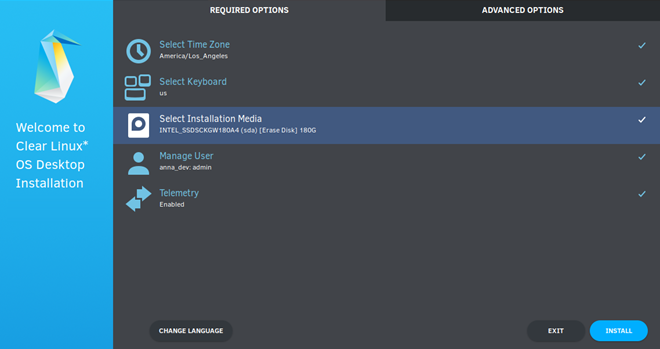Clear Linux - In Memoriam

Do all good things come to an end? I disagree. However, reality can be brutal sometimes. Intel closed another open source project, Clear Linux OS, as announced in this thread. Can we say, "Big Evil Corp getting rid of open source"? Well, partially, at some point. Hopefully, Intel will continue to contribute to Linux and support Intel hardware, including CPUs, Intel Arc graphics cards, network cards, AI accelerators, and more.
There are rumors about mass layoffs at Intel, and sadly, the Clear Linux team is probably part of these layoffs. Nearly 20,000 people will be laid off, with around 5,000 of those being from the Clear Linux team. Despite the morale-boosting statement below, this raises big questions about Linux support for Intel products.
Rest assured that Intel remains deeply invested in the Linux ecosystem, actively supporting and contributing to various open-source projects and Linux distributions to enable and optimize for Intel hardware.
Only time will tell if it will actually happen. One thing we know for sure is that Clear Linux was a game changer in the Linux ecosystem. Like many Linux users, I first saw it on the Phoronix.com website, where it earned a decent benchmark score and outperformed many Linux distributions. Then, I tried the LiveCD on my laptop, and the difference from the installed Linux distribution was enormous—it was just like a new laptop! Other Linux distributions then adopted some performance optimizations because constantly losing in benchmarks definitely doesn't raise the project's reputation.
So, what else did Clear Linux do besides win the benchmarks? First, the performance and optimizations are important. It's not easy and it takes time. For some people, it's better to spend money on it. Many Linux distributions have invested in performance, including special builds for x86 microarchitectures.
The Clear Linux team patched software compilers, including GCC, and the Linux kernel, to improve performance. Some of these patches were adopted by other Linux distributions. They also widely used LTO (link-time optimization) and PGO (profile-guided optimization), which became more popular. The same happened with AVX (Advanced Vector Extensions), AVX2, AVX512 and beyond. The package manager, swupd, can identify the current CPU capabilities and download the optimal ELF files and libraries for optimal system performance.
The most interesting Clear Linux system design feature is probably stateless concept. "State" refers to user configuration or any non-default configuration applied. A real split between user data and configuration allows for the complete removal or replacement of the user configuration. In classical Linux distributions, with their mix of configuration files in the /etc directory, it is difficult to tell whether a configuration file is provided by default or not. The Clear Linux default /etc directory is empty, and the OS will boot successfully even if it is wiped. So, where is the default system configuration? In /usr/share/defaults. If an application cannot find its configuration file in /etc, it will be forced to load the default file from /usr. All files in /usr/, /lib/, /lib64/, /bin/, and /sbin/ are immutable because swupd will overwrite them with OS updates. The /usr/lib/modules/, /usr/lib/kernel/, /usr/local/, and /usr/src/ directories are whitelisted for kernel drivers and third-party software. There is no /etc/fstab by default; systemd can discover and mount all system partitions.

The Clear Linux installer is written from scratch in Go and GTK. It has a minimalist interface and supports manual and automatic installation, disk encryption, telemetry (which is disabled by default), network proxies, and more.
Clr-boot-manager is also written by Intel. The bootloader lacks BIOS support by design, but there's a workaround. The Clear Server edition can be loaded on non-UEFI machines thanks to Syslinux. Compared to the much larger Grub2, Clear is very easy to work with.
The kernel boot options should be defined in /etc/kernel/cmdline.d/*.conf, and these changes require the clr-boot-manager update command to become permanent. The complexity of the Grub2 architecture and its 10x larger codebase are probably the main reasons for giving up, along with the decreased boot time. /proc/rootfstype lists the supported file systems for the root partition, including ext4, btrfs, xfs, and f2fs. ZFS isn't supported, but an OpenZFS guide is available for non-root partitions.
Another notable project in Clear Linux is autospec - a highly automated tool for creating RPM packages from source code. It analyzes the source code and build system information, such as the Makefile. Then, it runs a build in a mock sandbox and suggests or adds fixes based on previous failures. For example, it can suggest adding a dependency. This tool can significantly speed up a maintainer's work.
Clear Linux has been discontinued but there's no reason to be sad or disappointed. The free and open-source software ecosystem sometimes acts similarly to space: when a star dies, some of its parts can become building materials for another star, asteroid, or even a planet. So, the Clear software and ideas have a chance to be applied to other Linux projects sooner or later.
Finally, there are other active Linux distributions for people interested in performance:
- AerynOS, a revolutionary distribution created by Ikey Doherty, ex Clear Linux team member. Wildly improved a lot of Clear Linux ideas.
- CachyOS, which is very optimized by performance adopted some Clear Linux patches, software and ideas, currently #1 on Distrowatch.com.
- Bazzite, an OS optimized for gaming and everyday smoother and simpler use across desktop PCs, handhelds, tablets, and home theater PCs.




